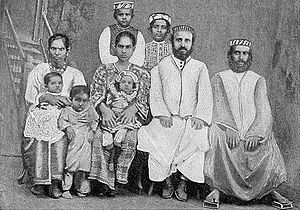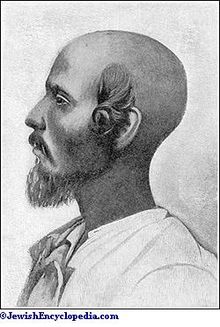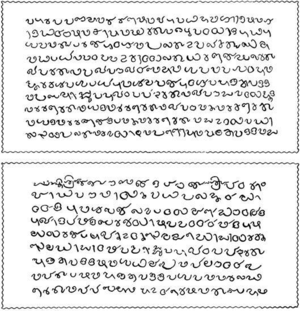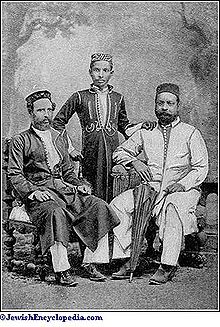- Cochin Jews
-
Cochin Jews 
Total population 8500 (estimated) Regions with significant populations  Israel 8,000 (estimated)
Israel 8,000 (estimated)
Kerala 51 (including Kochi (17 in 2006[1]), Ernakulam, North Paravur, Aluva)
 India
IndiaLanguages Traditionally, Judeo-Malayalam, now mostly Hebrew
Religion Related ethnic groups Paradesi Jews
Sephardic Jews in India
Bene Israel
Baghdadi JewsCochin Jews, also called Malabar Jews (Malabar Yehudan), are the oldest group of Jews in India, with roots claimed to date to the time of King Solomon, though historically attested migration dates from the fall of Jerusalem in 70 CE. Historically, they lived in the Kingdom of Cochin in South India,[2] now part of the state of Kerala. Several rounds of immigration of the Jewish diaspora into Kerala led to an ethnic, but not a linguistic, diversity: the community was divided into White Jews and Black Jews, both of which spoke Judeo-Malayalam, a form of the Malayalam tongue native to the state.[3] The vast majority of the Cochin Jews emigrated to Israel; the number remaining in Kerala itself is minuscule, and the community faces extinction there.[4]
Contents
History
Further information: History of KochiFirst Jews in South India
Traders in King Solomon's time carried out regular sea voyages to the South Indian coast, bartering for ivory, apes, and silver, and the first Cochin Jews may have been the children of Israelite sailors and local women.[5] It has been claimed that following the destruction of the First Temple in the Siege of Jerusalem (587 BC), some Jewish exiles came to India.[6] But it was after the destruction of the Second Temple in 70 CE that the first wave of large numbers of settlers came to Cranganore, an ancient port near Cochin.[7] Cranganore, now transliterated as Kodungallur, but also known under other names, is a city of legendary importance to this community. Fernandes goes so far as to call it "a substitute Jerusalem in India"[8] and Katz and Goldberg note the "symbolic intertwining" of the two cities.[9]
St. Thomas, one of the disciples of Jesus, is supposed to have visited India, and many of the Jews who converted to Christianity at that time were absorbed by Nasrani or Saint Thomas Christians.[10]
Central to the history of the Cochin Jews is their close relationship with Indian rulers, and this was eventually codified on a set of copper plates granting the community special privileges. The date of these plates, known as "Sâsanam",[11] is contentious, with local tradition setting it as long ago as 379 CE, although paleographic evidence suggests the mid-eighth century. Whatever the date, the Jewish leader Joseph Rabban was granted the rank of prince over the Jews of Cochin, given the rulership and tax revenue of a pocket principality in Anjuvannam, near Cranganore, and rights to seventy-two "free houses".[12] The Hindu king gave permission in perpetuity (or, in the more poetic expression of those days, "as long as the world and moon exist") for Jews to live freely, build synagogues, and own property "without conditions attached".[13][14] A link back to Rabban, "the king of Shingly" (another name for Cranganore), was a sign of both purity and prestige. Rabban's descendants maintained this distinct community until a chieftainship dispute broke out between two brothers, one of them named Joseph Azar, in the sixteenth century.
The oldest gravestone of a Cochin Jew is written in Hebrew and dates to 1269 CE. It is near the Chendamangalam Synagogue, now a museum[15]
In 1341 a disastrous flood silted up the port of Cranganore, and trade shifted to a smaller port at Cochin (Kochi). Many of the Jews moved quickly, and within four years the first synagogue had been completed.[16] The Portuguese Empire established a trading beachhead in 1500, and until 1663 remained the dominant power. They were not kind to the Jews.
Paradesi Jews arrive
 Black jew of cochin with Payot
Black jew of cochin with Payot
The Paradesi Jews, also called "White Jews", settled in the region at about this time. In the sixteenth century, Sephardi Jews faced religious persecution under the Inquisition, and, along with the Islamic Moors, were exiled from the Iberian peninsula, where they had thrived for centuries. Some fled north to Holland and England but the majority fled east to the Ottoman Empire and beyond, with some following the Arab spice routes to southern India. They brought with them the Ladino language and their Sephardic customs. They found the Black Malabari Jewish community quite different, and tensions between the two communities existed from early on, according to Mandelbaum[17] The European Jews had good trade links with their countries of origin, and useful languages to conduct international trade, which helped their position both financially and politically.
In 1524, the Muslims, backed by the ruler of Calicut (today called Kozhikode and not to be confused with Calcutta), attacked these wealthy Jews of Cranganore on the pretext that they had an advantage with the pepper trade. The Jews fled south to the Kingdom of Cochin, seeking the protection of the Cochin Royal Family (Perumpadapu Swaroopam). The Hindu Raja of Cochin, Bhaskara Ravi Varman II (979— 1021) gave them asylum. Moreover, he exempted Jews from taxation but bestowed on them all privileges enjoyed by the tax-payers.[18]
Shortly thereafter, the Portuguese occupied the Kingdom of Cochin and suppressed the Jews until the Dutch displaced them in 1660. The new Protestant rulers were more tolerant of the Jews than the Catholics had been. (See the Goa Inquisition for the situation in nearby Goa.)
From 1660 to now
For centuries the Cochin Jews were divided by the colour line. The White (Paradesi) Jews were dismissive of the Black (Malabari) Jews, and denied them access to the Paradesi Synagogue. There were moves against this discrimination dating back to the 1520 ruling of Rabbi ibn Zimra and, later, that of his student Rabbi Jacob de Castro in Alexandria. In the early twentieth century there arose a "Jewish Gandhi",[19] a young lawyer named Abraham Barak Salem (1882–1967), who devoted his life to ending such discrimination and other divisions among the Cochin Jews. He was both an Indian nationalist and Zionist.[20] His family were meshuchrarim, a Hebrew word used, sometimes neutrally and sometimes with derogatory intent, to denote a manumitted slave. The few score meshuchrarim belonging to the White Jewish community were discriminated against by other White Jews, being relegated to a subordinate position in the synagogue and community. The White Jews also considered themselves racially distinct from the more numerous Black (or Malabari) Jews who had preceded them on the Malabar coast.
The Black Jews had seven places of worship; the White Jews had only one, the Paradesi Synagogue, which for centuries had been barred to those whom they considered impure. Fernandes calls it "a bastion of white purity".[21] The stratification in the Jewish community prevented the meshuchrarim from marrying other White Jews and forced them to sit in the back of the synagogue with the Black Jews in a manner resembling the discrimination against converts from lower castes sometimes found in Christian churches in India. Salem fought against this by boycotting the synagogue for a time and utilised satyagraha as a means of combating discrimination within the community. Salem's efforts were successful, and by the mid-1930s, Mandelbaum reported that many of the old taboos had fallen.[22]
Today most of Cochin's Jews have emigrated. Most of them went to Israel (made aliyah), where large groups went to the moshavs (agricultural settlements) of Nevatim and Shahar in the Negev (southern desert), of Yuval in the North, and of Mesilat Zion between Jerusalem and Tel Aviv. Others have settled in the neighborhood of Katamon in Jerusalem, in Beer Sheva, Dimona and Yeruham.
Part of the decline in Kerala's Jewish population can also be attributed to conversion.[10] Largely, however, it appears to be due to internal schism, the apartheid between White and Black Jews.[23]
In Cochin, the Paradesi Synagogue still functions, and is also a tourist attraction. The ticket-seller, Yaheh Hallegua, is the last female Paradesi Jew of child-bearing age.[24]
Traditions and way of life
The 12th century Jewish traveler Benjamin of Tudela wrote about the Malabari coast of Kerala: "The inhabitants are all black, and the Jews also. The latter are good and benevolent. They know the law of Moses and the prophets, and to a small extent the Talmud and Halacha."[25] Maimonides (1135–1204), the preeminent Jewish philosopher of his day, wrote, "Only lately some well-to-do men came forward and purchased three copies of my code [the Mishneh Torah] which they distributed through messengers.... Thus the horizon of these Jews was widened and the religious life in all communities as far as India revived."[26] (The Baghdadi Jews came to India in the 18th century, and it was only then that the Bene Israel Jews of India were "discovered" and taught mainstream Judaism by the Cochinis and Baghdadis,[27] so Maimonides must be referring to the Cochini Jews.)
Further support for the Mishneh Torah circulating in India comes in the form of a letter sent from Safed, Israel to Italy in 1535. In it David del Rossi claimed that a Jewish merchant from Tripoli had told him the India town of Shingly (Cranganore) had a large Jewish population who dabbled in yearly pepper trade with the Portuguese. As far as their religious life, he wrote they: "only recognize the Code of Maimonides and possessed no other authority or Traditional law."[28] According to Katz, Rabbi Nissim of Gerona (the Ran) visited the Cochini Jews, and they preserve in their song books the poem he wrote about them.[29] In the Kadavumbagham synagogue, there was a yeshiva (school) for both "children's education and adult study of Torah and Mishnah."[30]
The early twentieth century Jewish Encyclopedia states, "Though they neither eat nor drink together, nor intermarry, the Black and the White Jews of Cochin have almost the same social and religious customs. They hold the same doctrines, use the same ritual (Sephardic), observe the same feasts and fasts, dress alike, and have adopted the same language Malayalam. ... The two classes are equally strict in religious observances,"[31] and prominently featured is a black Cochin Jew with his entire head shaved, save for his very prominent peyot. According to Chemana, the Jews of Cochin "coalesced around the religious fundamentals: devotion and strict obedience to Biblical Judaism and to the Jewish customs and traditions ... Hebrew, taught through the Torah texts by rabbis and teachers who came especially from Yemen...".
It is notable that the Jews of Cochin did not adhere to the Talmudic prohibition against public singing by women (kol isha), and therefore have always had a rich tradition of Jewish prayers and narrative songs performed by women in Judeo-Malayalam.[32][33][34] (However, this Talmudic prohibition is not absolute; there are in fact traditional Orthodox interpretations that sanction certain kinds of singing performances by women before men, and other historical Jewish communities besides the Cochini one relied on this lenient interpretation.[35])
Benedicta Pereira, a Paradesi Jew, writes, "Mostly the older people prohibited the use of milk and meat the same day in the house[;] and to scare the young Jew's[,] [sic] so as not to be inspired by the culture[,] there were stories of bad Omens for those who dare[d] to think even of milk and meat together."[36]
See also
Notes
- ^ Out Of India
- ^ Katz 2000; Koder 1973; Menachery 1998; Thomas Puthiakunnel 1973; Weil 1982; Menachery 1998.
- ^ Katz 2000; Koder 1973; Thomas Puthiakunnel 1973.
- ^ The Last Jews of Kerala, Edna Fernandes, Portobello Books 2008
- ^ (1 Kings 10:22), The Jews of Kerala, P. M. Jussay, cited in The Last Jews of Kerala, p. 98
- ^ The Last Jews of Kerala, p. 98
- ^ Katz 2000; Koder 1973; Thomas Puthiakunnel 1973; David de Beth Hillel, 1832; Lord, James Henry 1977.
- ^ The Last Jews of Kerala, p. 102
- ^ cited in The Last Jews of Kerala, p. 47
- ^ a b Weil S. 1982; Jussay P.M. 1986; Menachery 1973; Menachery 1998.
- ^ Burnell, Indian Antiquary, iii. 333–334
- ^ taken from WP article on Rabban, which appears to rely on Ken Blady's book Jewish Communities in Exotic Places. Northvale, N.J.: Jason Aronson Inc., 2000. pp. 115–130.
- ^ Three years in America, 1859–1862 (p. 59, p. 60) by Israel Joseph Benjamin
- ^ Roots of Dalit history, Christianity, theology, and spirituality (p. 28) by James Massey, I.S.P.C.K.
- ^ The Last Jews of Kerala, pp. 81–82
- ^ The Last Jews of Kerala p. 111
- ^ Cited on p 51 in The Last Jews of Kerala
- ^ Who are the Jews of India?(p.34,p.35)By Nathan Katz
- ^ A Kochi dream died in Mumbai Indian Express – December 13, 2008
- ^ PANEL 39: Nationalisms and their Impact in South Asia – European Association of South Asian Studies
- ^ The Last Jews of Kerala p. 155
- ^ Cited on p164 of The Last Jews of Kerala
- ^ The Last Jews of Kerala, throughout
- ^ Abram, David (in English). The Rough Guide to Kerala (2nd ed.). London, United Kingdom: Penguin Books. p. 181. ISBN 9781848365414.
- ^ Adler, Marcus Nathan. The Itinerary of Benjamin of Tudela: Critical Text, Translation and Commentary. New York: Phillip Feldheim, Inc., 1907.
- ^ Twersky, Isadore. A Maimonides Reader. Behrman House. Inc., 1972, pp. 481–482
- ^ Herzog, Avigdor, "India", in Encyclopedia Judaica, 2008.
- ^ Katz, Nathan and Ellen S. Goldberg. The Last Jews of Cochin: Jewish Identity in Hindu India. University of South Carolina Press, p. 40. Also, Katz, Nathan, Who are the Jews of India?, University of California Press, 2000, p. 33.
- ^ Katz, Who are the Jews of India?, op. cit., p. 32.
- ^ ISJM Jewish Heritage Report, Volume II, numbers 3–4.
- ^ Jacobs, Joseph and Joseph Ezekiel. "Cochin", 1901–1906, pp. 135–138.
- ^ Chemana, Martine. "Women sing, men listen: Malayalam folksongs of the Cochini, the Jewish Community of Kerala, in India and in Israel," trans. from "Les femmes chantent, les hommes écoutent. Chants en malayalam (pattu-kal) des Kochini, communautés juives du Kerala, en Inde et en Israël," in Bulletin du Centre de recherche français de Jérusalem, November 2002. French original, English translation
- ^ Pradeep, K. "Musical Heritage", in The Hindu (Online edition of India's National Newspaper), 15 May 2005.
- ^ Johnson, Barbara C. "Cochin: Jewish Women's Music". Jewish Women: A Comprehensive Historical Encyclopedia. 1 March 2009. Jewish Women's Archive.
- ^ Michael Makovi, forthcoming article in May 2010 issue of Conversations, published by the Institute for Jewish Ideas and Ideals, and the sources cited therein.
- ^ Benedicta Pereira. "Kerala Jews". Shalom Online (David Shalom and Benedicta Pereira). 2010-01-26. URL:http://www.shalom2.20m.com/page3.htm. Accessed: 2010-01-26. (Archived by WebCite at webcitation.org)
References
- Fernandes, Edna. (2008) The Last Jews of Kerala. London: Portobello Books. ISBN 978-1-84627-098-7
- Koder, S. "History of the Jews of Kerala". The St. Thomas Christian Encyclopaedia of India, ed. G. Menachery, 1973.
- Puthiakunnel, Thomas. (1973) "Jewish colonies of India paved the way for St. Thomas", The Saint Thomas Christian Encyclopedia of India, ed. George Menachery, Vol. II., Trichur.
- Daniel, Ruby & B. Johnson. (1995). Ruby of Cochin: An Indian Jewish Woman Remembers. Philadelphia and Jerusalem: Jewish Publication Society.
- de Beth Hillel, David. (1832) Travels; Madras publication.
- Jussay, P.M. (1986) "The Wedding Songs of the Cochin Jews and of the Knanite Christians of Kerala: A Study in Comparison". Symposium.
- Hough, James. (1893) The History of Christianity in India.
- Lord, James Henry. (1977) The Jews in India and the Far East. 120 pp.; Greenwood Press Reprint; ISBN 0-8371-2615-0
- Menachery, George, ed. (1998) "The Indian Church History Classics", Vol.I, The Nazranies, Ollur, 1998. ISBN 81-87133-05-8
- Katz, Nathan; & Goldberg, Ellen S; (1993) The Last Jews of Cochin: Jewish Identity in Hindu India. Foreword by Daniel J. Elazar, Columbia, SC, Univ. of South Carolina Press. ISBN 0-87249-847-6
- Menachery, George, ed. (1973) The St. Thomas Christian Encyclopedia of India B.N.K. Press, vol. 2, ISBN 81-87132-06-X, Lib. Cong. Cat. Card. No. 73-905568 ; B.N.K. Press
- Weil, S. (1982) "Symmetry between Christians and Jews in India: The Cananite Christians and Cochin Jews in Kerala". Contributions to Indian Sociology, 16.
Further reading
- Chiriyankandath, James. (2008) "Nationalism, religion and community: A. B. Salem, the politics of identity and the disappearance of Cochin Jewry", Journal of Global History 3, 1: 21–42.
- Day, Francis. The Land of the Permauls, Or, Cochin, Its Past and Its Present, offers insight to Cochin Jewish life in 18th century, read Volume VIII (page 336 to 354). Francis Day was a British civil surgeon in 1863.
- Katz, Nathan. (2000) Who Are the Jews of India?; Berkeley, Los Angeles and London, University of California Press. ISBN 0520213238
- Katz, Nathan; Goldberg, Ellen S; (1995) "Leaving Mother India: Reasons for the Cochin Jews' Migration to Israel", Population Review 39, 1 & 2 : 35–53.
- Weil, Shalva. (eds) (2002) India's Jewish Heritage Ritual, Art & Life Cycle; Marg Publications. ISBN 8185026580
External links
- Cochin Jews
- Calcutta Jews – Jewish Encyclopedia
- Cochin Jewish musical heritage (article from South Indian newspaper 'The Hindu')
- Dr Francis Day's recollections on Cochin jews, Circa 1863 AD
- Cochin Jews Research
- news item regarding presentation of Cochin Jewish history to Mr Ariel Sharon, by Indian officials
Categories:- Kochi, India
- Jews and Judaism in India
- Kerala society
- Indian Jews
- Jewish ethnic groups
- Social groups of Kerala
- The Lost Tribes
Wikimedia Foundation. 2010.





